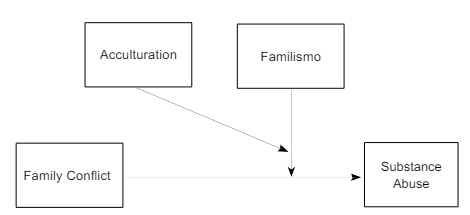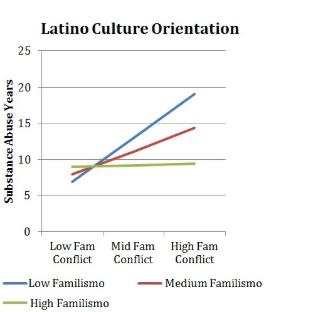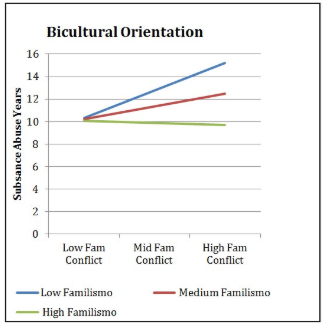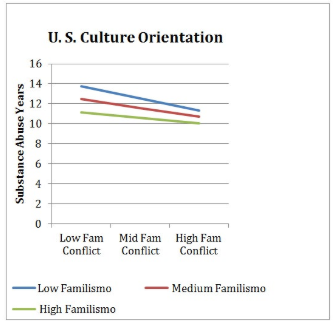INTRODUCTION
Disparities in substance abuse rates and substance abuse treatment (SAT) utilization among Latinos remain significant.1,2,3,4,5 National data report binge alcohol use for Latino adults was 24.1% with higher number of drinks consumed for Latinos than other non-Hispanic racial or ethnic groups.6 The same trend is observed among Latino men age 26-49, where 7.5% of them engaged in illicit drug use in the past month.7 Despite the percentage of Latinos who needed treatment in the last year (9.9%) is not significantly different from their non-Latino counterparts (9.2%), Latinos are less likely than other ethnic groups to receive substance abuse treatment (SAT) (9.7% vs. 10.2% respectively),7 less likely to complete SAT (odds ratio (OR)=.82; 95% confidence interval (CI) .68, .99),3 and more likely to experience substance use-related risk behaviors than their European American counterparts.8
As the Latino population increases,9 the need to identify factors that contribute to better SAT outcomes increases as well.10,11 The limited literature in SAT utilization suggests that Latinos are less satisfied with treatment12 and report high rates of unmet needs (98.60% for alcohol and 90.61% for drug abuse).13 Existing SAT programs may overlook unique needs that are important for Latinos in recovery from substance use.3,14,15 Despite calls for the incorporation of cultural aspects at all different stages of substance use prevention and treatment,7 research on cultural constructs in relation to substance use behavior remains neglected.
In the Latino culture, family is the social core where cultural values and social conventions are transmitted through social learning.16 The social control theory17 posits that strong bonds with close and extended family members promote responsible behavior and discourage individuals from engaging in substance use behavior.18 However, Latinos with history of family conflict may contend with considerable strain that is associated with increased substance abuse rates.19,20,21 Among Latinos, males are seven times more likely to have a chronic drinking problem22 and have higher use of illicit substances than women.23 Taken together, given that family is the first and most influential institution that provides support against environmental hardships,24 research is needed to investigate the role of cultural values in reducing substance use behavior on Latino males.15,25
FAMILY CONFLICT
Empirical studies consistently suggest that family promotes a safe environment where individuals learn self-regulation and socioemotional skills.26 Research also suggests the link between families characterized by hostility and poor nurturing and substance abuse.27 Individuals with a history of family conflict are more likely to engage in alcohol and substance abuse,28,29 and have higher alcohol and drug relapse.30 The limited literature on Latino families suggest that family conflict is associated with an increased risk of anxiety and distress31 that may lead Latinos to engage in substance use behavior as a coping mechanism. A recent study conducted on 446 Latino adults who completed SAT found that reduced family conflict led to decrease substance use behavior pre- and post-treatment.32 These findings support the need for research on cultural factors that contribute to reduce substance use behavior.
FAMILISMO AND ACCULTURATION
Familismo remains as a fundamental cultural value for most Latinos.33 Main aspects of this cultural construct are feelings of mutual obligation, reciprocity, and solidarity towards one’s family members.34 While Familismo has been found to reduce substance abuse, protect against environmental factors, and negative mental health outcomes,4 it has been noted when these family dynamics are dysfunctional it can increase the risk for using alcohol and drugs.19,35 However, endorsement of familismo in Latinos may fluctuate as a result of the acculturation.21,34,36 Through a comparative cognitive exercise expressed through language or attitudes, individuals shape their perception of the world, others, and self by adopting characteristics of the mainstream culture and retain or relinquish traits of their traditional background.37 Although acculturation has been studied in relation to substance abuse outcomes on Latina/o adolescents,38,39 there are no studies that have examined the interaction between Familismo and acculturation in a clinical sample of Latino adult males who completed SAT.
THE PRESENT STUDY
The examination of cultural constructs at different levels of acculturation is needed to understand key cultural aspects that inform culturally-appropriate, evidence-based substance use prevention and treatment for Latinos.3,40,41 The current study explores the association between history of family conflict and years of substance abuse in a sample of Latino adult males who recently completed SAT. Specifically, we hypothesize that, acknowledging the role of Familismo in promoting social control,17,18 the path from history of family conflict to years of substance abuse is reduced by the moderator Familismo. As adherence to cultural values varies at participants’ level of acculturation, we also hypothesize that Familismo moderates the aforementioned association at different levels of acculturation (Figure 1). Generational status (i.e., immigrant vs. US born) and age are used as covariates. Findings from the present study will shed light on the role of Familismo and cultural orientation in reducing substance use behavior among Latino males who recently completed SAT.
Figure 1: Theoretical model of the proposed multiple moderation model.

METHODS
Participants
Participants for this study were recruited from substance abuse treatment facilities and community-based organizations located in the metropolitan area of Chicago. The criteria for participation were 1) identified as Latina/o, and 2) either having successfully participated in a substance abuse treatment program or having remained abstinent from alcohol and/or illicit substances. For the present study, Latino males who completed baseline assessment were included in the analysis. There were 117 Latino male participants (Mage=37 years; SD±10.3 years). More than half of the participants immigrated from Puerto Rico, Mexico and other Central American countries (54%), with a mean length of stay of 19 years (SD±13.87 years) in the United States.
Setting and Procedure
The present study was approved and monitored by the Institutional Review Board of DePaul’s Office of Research Services (ORS). Recruitment of participants took place from fall 2009 to spring 2012 for a larger National Institutes of Health (NIH) funded study aimed to examine recovery homes for Latinos in recovery from substance abuse.42,43 A cadre of bilingual/bicultural recruiters and research assistants collaborated in the outreach, recruitment and assessment of Latina/o participants. Research assistants utilized Internet search engines (i.e., Google, Yahoo) and state wide databases of health services and mental health providers to generate a list of substance treatment programs, hospitals, and community-based agencies servicing Latinos. The outreach strategy consisted of contacting these sites via phone and email to introduce the study. A team of Oxford House alumni, two of them Latinos, worked to establish ties with staff and potential participants at various treatment centers. Recruiters provided information on community-based recovery home options, described the nature of the study to potential participants, and facilitated the interview process. All participants were given an explanation about the nature, purpose and goals of the study before signing consent forms. Participants were interviewed in their language of preference (i.e., English or Spanish). Interviews took place at treatment facilities, a private location within an Oxford House, or at DePaul University’s Center for Community Research. After completing the interview, participants received $30 as a compensation for their participation.
Measures
Demographics: A demographic questionnaire was used to collect participants’ age, gender, place of birth, treatment setting, and country of origin. Participants were asked to report their place of birth and were assigned either to the immigrant or US born group. We determine to place Puerto Ricans who were born in the island in the immigrant group despite being US citizens by birth. Our rationale is that Puerto Ricans, who were born in the island endorse traditional cultural values and norms similar to those of other Latin American countries.
Family conflict: The addiction severity index (ASI), 5th Edition44 assesses problems during the individual’s lifetime and during the 30 days prior to the interview in seven areas: alcohol use, drug use, illegal activity, interpersonal and family relations, medical problems, employment, and psychiatric problems. English and Spanish versions of the ASI were used, depending on participants’ stated language preference. The 5th Edition of the ASI has been used with Latino participants in several large studies and yielded strong psychometric properties.14,45,46 The Spanish translation was back translated and pilot tested prior to undergoing a validation study.47 Correlations for the test-retest reliability of the English and Spanish versions of the ASI range from .80 to .90. For the present study, a composite of family conflict lifetime was derived from items measuring conflict with father, mother, sibling, spouse/significant other, and children. An example of these items is the following: “have you had significant periods in your life which you have experienced serious problems with your father?” Participants responded no=0, yes=1, or N/A=not applicable. A composite was created by obtaining the sum of “yes” answers divided by the sum of “yes” and “no” answers; the N/A answers were not included in the composite as some of these relationships many not apply to them. In addition, the mean years of substance abuse was computed using the mean of alcohol use to intoxication, heroin, cocaine, marijuana, and amphetamines lifetime. High scores indicate greater problem severity.
Acculturation: A composite of acculturation was computed using the scores from the Non-Hispanic and Hispanic subscales of the Bidimensional Acculturation Scale (BAS)48; and the mean score from the Psychological Acculturation Scale (PAS).49 The Non-Hispanic subscale was reversed as to have both composite scores following the same direction. Mean scores from the Hispanic and non-Hispanic subscales of the BAS as well as the mean of the PAS were standardized (converted into z-scores) to resolve the discrepancy created by the use of different Likert scales. Below there is psychometric data on the measures used for the composite of acculturation.
The bidimensional acculturation scale for hispanics (BAS)48: The BAS is a 24-item, 4-point Likert-type (1=low or not well to 4=high or very well) self-report measure of English and Spanish use as a proxy for acculturation. Three subscales measure language use, linguistic proficiency, and use of electronic media subscales in both Spanish and English. An item sample of the language subscale includes “how often do you speak English?”. The Hispanic and Non-Hispanic domain scores are derived from the total scale, where scores higher than 2.5 suggest high acculturation. Good to high internal consistency (α=.81-.97) and high correlation with other behavioral measures of acculturation, such as generation in the US and proportion of life spent in the US are reported.48
The psychological acculturation scale (PAS)49: The PAS is a 10-item, 9-point Likert-type scale (1=only with Latinos to 9=only with Anglos) self-report measure that assesses sense of attachment to and belonging within the US and Hispanic/Latino cultures. An item sample includes “with what group of people do you feel you share most of our beliefs and values?” A mean total score is derived from the scale, where a score of 5 indicates bicultural orientation. Both the English and Spanish versions of the PAS have good internal consistency (α=.90 and .83) and correlate with language and cultural preferences, along with percentage of life spent in the US and measures of cultural values.50 The PAS has been used with a sample of Mexican Americans, Central Americans, and South Americans and has been found to be correlated with both the proportion of life spent in the US and measures of cultural values.50
Familismo: The Familismo scale51 is an 18-item, 10-point Likert-type (1=strongly disagree to 10=strongly agree) measure that assesses aspects of Latino familial values. Four subscales (familial support, familial interconnectedness, familial honor, and subjugation of self to family) measure adherence to Familismo values. An item sample of the familial interconnectedness subscale includes “a person should cherish the time spent with his or her relatives”. A total score was derived from the sum of the item responses, with high scores demonstrating endorsement of Familismo. Good internal consistency (α=.83) and validity (i.e., correlations with measures of acculturation, generation in the US, and proportion of life spent in the US) was reported with a sample of Latino adults.51
RESULTS
Preliminary analysis, using pairwise deletion to address the issue of missing data, were conducted to determine descriptive statistics. The final sample used for the model analysis was 117 participants (n=54 US born, n=63 non-US born), with a mean age of 37 years. Bivariate correlation analysis was conducted between history of family conflict and years of substance use to determine directionality and strength of the hypothesized association. Results from the correlation analysis indicate that family conflict was positively correlated with years of substance use (r=.23, p=<.05), and negatively correlated with age (r=-.33, p=<.01). Familismo was positively correlated with years of substance use (r=.20, p=<.05). Being born in the US was positively correlated with acculturation or affiliation to the US mainstream culture (r=.74, p=<.01) and negatively correlated with age (r=-.20, p=<.05). Acculturation, in turn, was negatively correlated with age (r=-.28, p=<.01). Means, standard deviations, and intercorrelations for all study variables are presented in Table 1.
| Table 1: Correlations, means, and standard deviations for the study variables. |
|
Measure
|
1 |
2 |
3 |
4 |
5 |
6
|
| 1. Family conflict |
—
|
|
|
|
|
|
| 2. Familismo |
-.04
|
—
|
|
|
|
|
| 3. Substance use index (lifetime) |
.23*
|
.20* |
—
|
|
|
|
| 4. Acculturation composite1 |
.17
|
-.06 |
-.05 |
—
|
|
|
| 5. Country of origin |
.16
|
-.05 |
-.06 |
.74** |
—
|
|
| 6. Age |
-.33**
|
.17 |
.58** |
-.28** |
-.20* |
—
|
| Mean |
.53
|
7.63 |
11.62 |
2.35 |
.46 |
37.26
|
| SD |
.35
|
1.06 |
7.18 |
.68 |
.50. |
10.31
|
A moderated regression was employed using the PROCESS macro for SPSS1 to test (a) the effects of history of family conflict and Familismo in predicting years of substance abuse after controlling for country of origin (Model 1), and (b) a multiple moderation model (Model 3) such that the relationship between family conflict and substance abuse was moderated by Familismo at different levels of acculturation. The PROCESS macro, a path analysis approach that estimates moderation models using an ordinary least squares regression, has the ability to generate the conditional effects and produces a table of estimated values of the outcome at different values of the predictor and moderator.1 Interaction plots were utilized to illustrate the contribution of Familismo to years of substance use at different levels of Acculturation (i.e., Latino orientation, bicultural orientation, US mainstream culture orientation).
First, a moderation model was used to test the role of Familismo as moderator of the association between history of family conflict and years of substance abuse at different levels of Familismo. Generational status and age were included as covariates. Results showed that history of family conflict predicted years of substance abuse (b=30.49, SE=13.19, p=.02). Moderation was supported, as the cross-product term of family conflict and Familismo was significant for years of substance abuse (b=-4.57, SE=1.71, t=-2.67, p=<.01), ∆R2=0.055, F(1,111)=7.13, p=<.01,). Note that the beta coefficients are unstandardized. The PROCESS macro produced the conditional effect of family conflict on years of substance abuse at values of the moderator Familismo. For Latino males who endorsed low Familismo scores (-1SD=6.56), history of family conflict was not related to years of substance abuse. Participants who endorse average (M=7.63), and high Familismo scores (+1SD=8.70), history of family conflict significantly interacted with Familismo to predict fewer years of substance abuse. The conditional effects of history of family conflict on years of substance were stronger in magnitude and significance for participants who endorse high values of Familismo (effect=-9.27, p=<.001) compared to those who endorse average levels of Familismo (effect=-4.39, p=.02). The Johnson-Neyman regions of significance indicated that the moderation was significant.
Then, a multiple moderation analysis was tested to examine Familismo as moderator of the association between history of family conflict and years of substance abuse at different levels of acculturation (i.e., cultural orientation). The proposed hypothesis was supported as the result from the multiple moderation model testing the conditional effect of the interaction family conflict and Familismo at different levels of acculturation was significant (b=6.36, t=2.17), ∆R2=0.042, F(1,107)=4.71, p=.03. The PROCESS macro generated the conditional effect of history of family conflict X Familismo interaction on years of substance abuse at different levels of acculturation. For participants with low acculturation (i.e., Latino orientation) and bicultural orientation, a reduction in years of substance abuse and history of family conflict was significant at average (M=7.64) and high values (+1SD=8.70) of Familismo (Figure 2). Specifically, the conditional effect of history of family conflict on years of substance abuse is stronger in magnitude and significance for Latino males with Latino orientation who endorse high values of Familismo (effect=-13.76, p=<.001) than those endorsing average values of Familismo (effect=-5.43, p=.03) (Figure 3). The same pattern is observed among Latino males with bicultural orientation, where conditional effects are stronger magnitude and significance for participants who endorse high values of Familismo (effect=-7.76, p=.003) than those with average levels of Familismo (effect=-4.08, p=.02) (Figure 4).
Figure 2: Conditional effect of history of family conflict on years of substance abuse among participants with Latino orientation.

Figure 3: Conditional effect of history of family conflict on years of substance abuse among participants with bicultural orientation.

Figure 4: Conditional effect of history of family conflict on years of substance abuse among participants with us mainstream culture orientation.

DISCUSSION
The primary purpose of the present study was to explore the moderating role of Familismo and acculturation in the association of history of family conflict with years of substance abuse in a sample of US Latino males, who completed SAT. First, we tested a moderation model where the path from history of family conflict to years of substance abuse varied at different levels of Familismo. Second, we tested a multiple moderation model to evaluate the moderating role of Familismo in the association of history of family conflict with years of substance abuse at different levels of acculturation (i.e., cultural orientation). Results from the moderation and multiple moderation models support the proposed hypotheses and illustrate the mechanism through which cultural orientation and Familismo moderate substance use behavior on Latino males.
First, the findings from the moderation analysis indicated that the association between history of family conflict and years of substance abuse decreased as participants endorsed average to high values of Familismo, after controlling for age and generational status (i.e., immigrant, US born). Results from the multiple moderation analysis indicate that, among participants with Latino and bicultural orientation, the conditional effect of the interaction between history of family conflict and years of substance abuse decreases at average and high values of the moderator Familismo. Specifically, the conditional effect of history of family conflict on years of substance abuse was stronger in magnitude and significance for participants with Latino and bicultural orientation who endorse high Familismo as compared to those with Latino and bicultural orientation who endorse average Familismo.
The most significant contribution of the present study are the findings illustrating the interaction between higher-order constructs (i.e., Familismo) and cultural orientation in decreasing substance use behavior on Latino males who completed SAT. These results expand on previous research on family conflict and substance abuse among Latino adolescents52 and Latino adults who completed SAT32 by including Familismo and cultural orientation as moderators of the above association. Results from the present study also support the social control theory17,18 in that high endorsement of Familismo may promote strong ties with family members, promoting behavior that is coherent with Latino values.53
Lastly, results from the present study are partially supported by acculturation studies19,22,41 that found endorsement of Latino orientation to be a protective factor for substance abuse.22,54 It appears intuitive that participants with Latino orientation (including those with bicultural orientation) are likely to endorse higher values of Familismo, a traditional value that shapes and it is influenced by social conventions.15,25 It is plausible that participants with strong Latino orientation and high endorsement of Familismo would engage in cognitive dissonance, which refers to the stress perceived by an individual who is conflicted with two or more contradictory beliefs or values.55 Cultural values may generate distress proportional by the degree to which the value is endorsed by the individual. In other words, participants with strong Latino orientation are more likely to reduce the dissonance generated by family conflict through the endorsement of thoughts promoting family loyalty and support. The same mechanism, but to a lesser extent, was observed on participants with bicultural orientation. Of note, although most participants’ responses on the Familismo scale fall around the mean (M=7.63 on a 1 to 10 Likert scale; SD=1.07), cognitive dissonance appeared to increase on participants as a function of their cultural orientation. That being said, it is plausible that individuals holding on traditional values (i.e., Familismo) are less likely to endorse culturally conflicting perceptions or values. On the contrary, participants who are less affiliated to the Latino culture and more affiliated to the US mainstream culture may endure more cognitive dissonance as they endorse conflicting values.
LIMITATIONS
The findings from the present study should be viewed in consideration of the following limitations. First, the small sample precluded us from using other variables of interest in the analyses. Second, data was collected from a mostly male alcohol and drug user sample and thus, gender comparisons could not be made. Third, although generational status was used as a covariate, further studies should explore generational differences in the association between family conflict and substance abuse. Fourth, other sources of conflict or distress (i.e., trauma) that may contribute to increased substance use behavior needs be examined. Fifth, the cross-sectional nature of the study did not allow for establishing causal inferences. Lastly, most participants were from Puerto Rican and Mexican background, which may limit generalization of findings to other Latino subcultures.
In order to develop sustainable and effective SAT programs, more research is needed to understand the underlying process through which cultural constructs promote reduced substance use behavior on Latinos. Specifically, substance use models that include cultural constructs and acculturation are needed to inform and develop culturally-tailored substance use prevention and treatment for Latino subgroups.56 From a community-centered approach, the use of values that are part of the Latino culture not only increases the odds of treatment adherence and completion, but it also empowers communities.57,58 In this vein, Latinos in recovery from substance abuse disorders may benefit from community-based recovery programs that utilize community assets.42,43 Our findings suggest that screening and assessing substance use should be complemented with the assessment of family conflict, cultural orientation, and key cultural constructs (i.e., Familismo, collectivism). The information gathered at pre- and post-treatment may be used for research as well as to inform SAT providers on important aspects to address in their clients’ aftercare plan. These results provide researchers, substance use counselors, and policy makers with a better understanding of the mechanisms through which Familismo and cultural orientation reduce substance abuse. In sum, our findings suggest that incorporating cultural aspects into treatment and in follow-up assessment may help in the prevention and treatment of substance use behavior on Latino males.
ACKNOWLEDMENTS
The authors appreciate the financial support from the National Institute on Alcohol Abuse and Alcoholism (NIAAA grant numbers AA12218 and AA16973). We also appreciate the revolving loan funds and support provided by the Illinois Department of Alcohol and Substance Abuse.
CONFLICTS OF INTEREST
The authors declare that they have no conflicts of interest.









